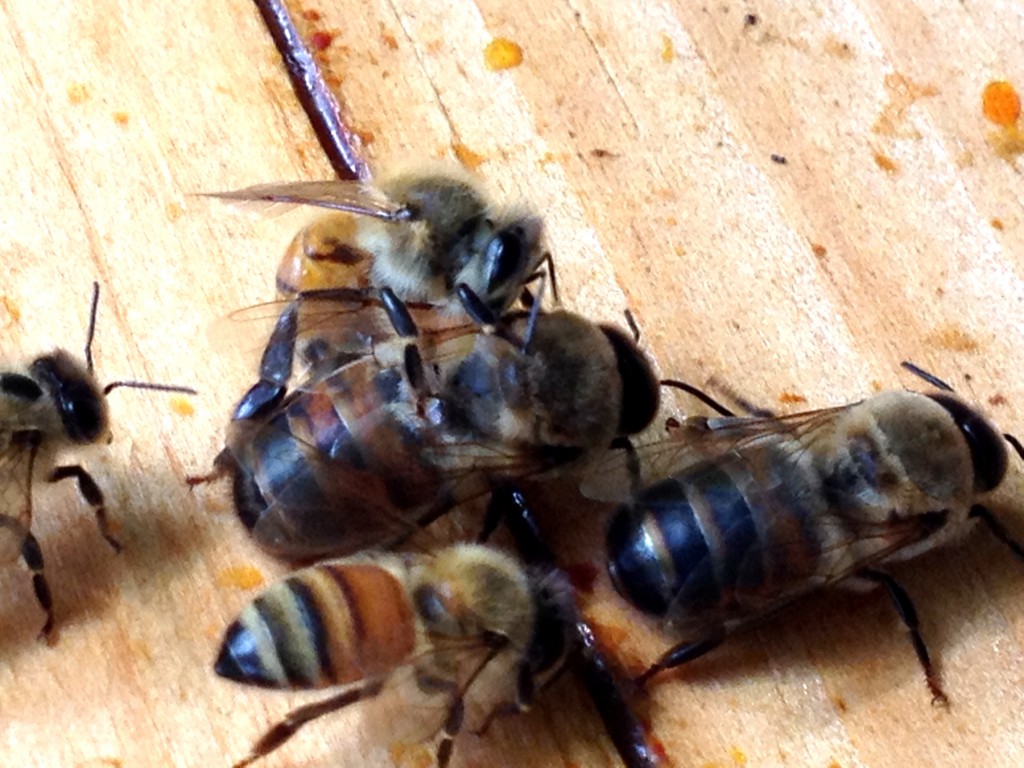Last year the mint was covered with this odd grey-faced fly. But I never saw them mate and this year I have not seen a single one of them.
This year we have many, many smelly Shield Bugs. They seem more interested in coming into the house than in actually mating:
But last year these two Cabbage White butterflies, and their friends, might have been responsible for the many Whites we see this year. (Mathematically there are 8 orientations for coupling but this one seems to be the most impersonal of all)
This summer we had some steamy heat and the Red bugs had fun.
Pursuit:
Contact:
The common yellow Wing Stem attracts others:
And even the slugs down on the ground were coyly eyeing each other.
For grace, the slender bright blue Dragonflies are the best. I’m unable to photograph them together in the air but fortunately they sometimes stop. I wonder which is which sex? I guess this might even be coupling position #9?
I’ve no idea what is happening here but the common Milkweed which I grew for the Monarchs (who never arrived this year) seems to be responsible.
Last year there were many, many bugs like this (Box Elders?), and this year none.
I don’t have any names for this elegant pair is but I do hope they laid some eggs.
There were a few more than the usual number of Japanese Beetles this year, but when they found a seemingly innocuous native plant called New Jersey Tea they went crazy:
One on one was not enough:
By the time they were finished they’d eaten all the leaves of the plant too.
My all-time favorite is the very elegant small Leaf Hopper that I find only on the native Jewel Weed plant. Yesterday I saw these two having fun. I did not have time to properly focus before they hopped off together.
And then there are the Walking Stick insects. I saw these live ones were in a small display case in a park in Charlotte, NC.
But the strangest of all are my bee Drones. Both my bee hives have a normal population of about 10% male drones who live all summer long supposedly doing nothing but eating the nectar and pollen brought in by the female workers. The Drones do fly to some unknown “Drone Congregation Place” where they supposedly wait for a new virgin queen to arrive from another hive. If the Drones ‘get lucky’, they die in the mating process. Why my hives should support Drones for the benefit of another hive is beyond me, other than that it is good for the bee species as a whole. Either way, as cold winter approaches, with no more surplus food, the females kick out the, to them, worthless drones from the hive. Here are two photos I took this week of smaller females ejecting (by biting?) the larger Drones (note their large, stingless rounded tails. If you ever see one you can pick him up in your fingers with no risk of being stung). The Drones reluctantly accept the situation and leave without offering too much resistance.
The video link below shows two female worker bees ejecting male drones almost twice their size. My vote of approval goes to Wanda who sticks to the drone, even after he gets into the hive entrance for a short moment. She wrestles him out and down the entrance ramp and eventually dumps him under the hive.
And so the various insect species survive the freezing winter, whether as egg or larva, in a compact hive or underground. It would be good to be able to see and photograph the new generation of each emerging next spring.

















Looks like the Monarchs didn’t show up at Point Pelee this year. That’s probably not a good sign.
http://www.cbc.ca/news/canada/windsor/point-pelee-national-park-cancels-monarch-butterfly-count-1.1868126
Great macro photos!
Only 8? I think your imagination may be a bit limited, Chris! There’s a book by Olivia Judson–“Dr. Tatiana’s Sex Advice to All Creation”–which probably goes into all this at some length. I haven’t read it, but you probably should.
Very nice work with the bug-finding and close focusing.
Amazing photos, Dad! I’m surprised those beautiful, colourful leaf-hoppers are tolerated in Ohio 😉